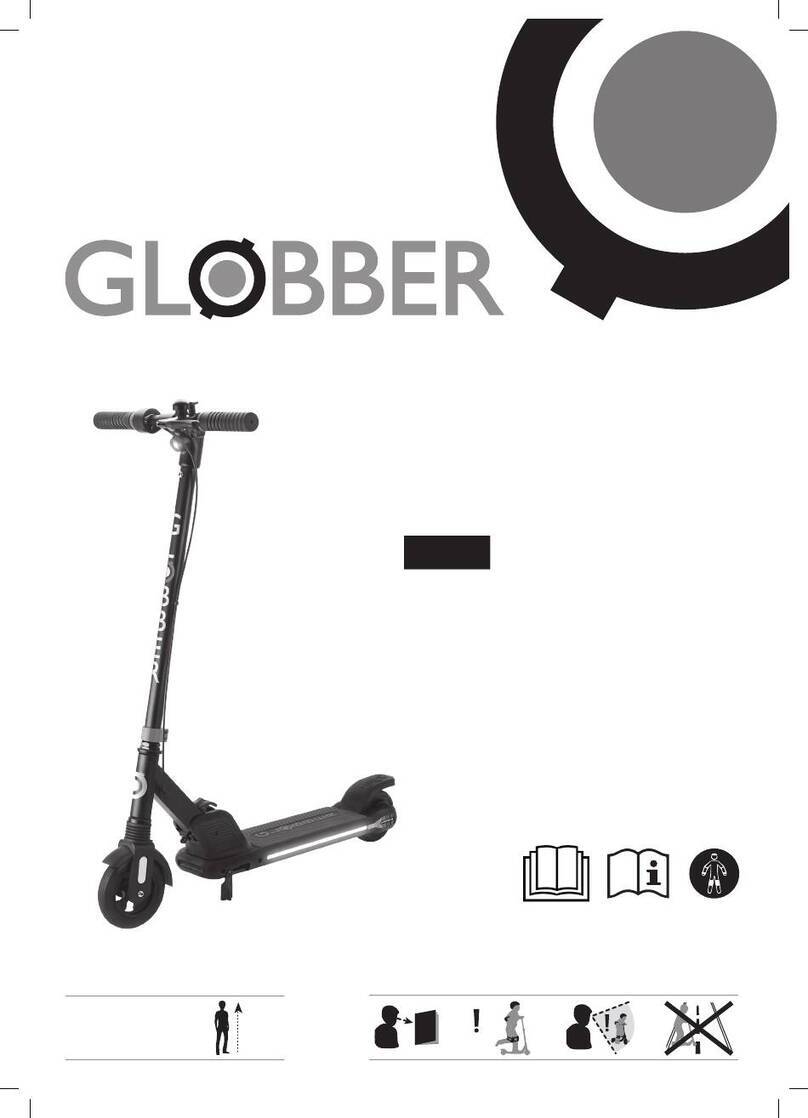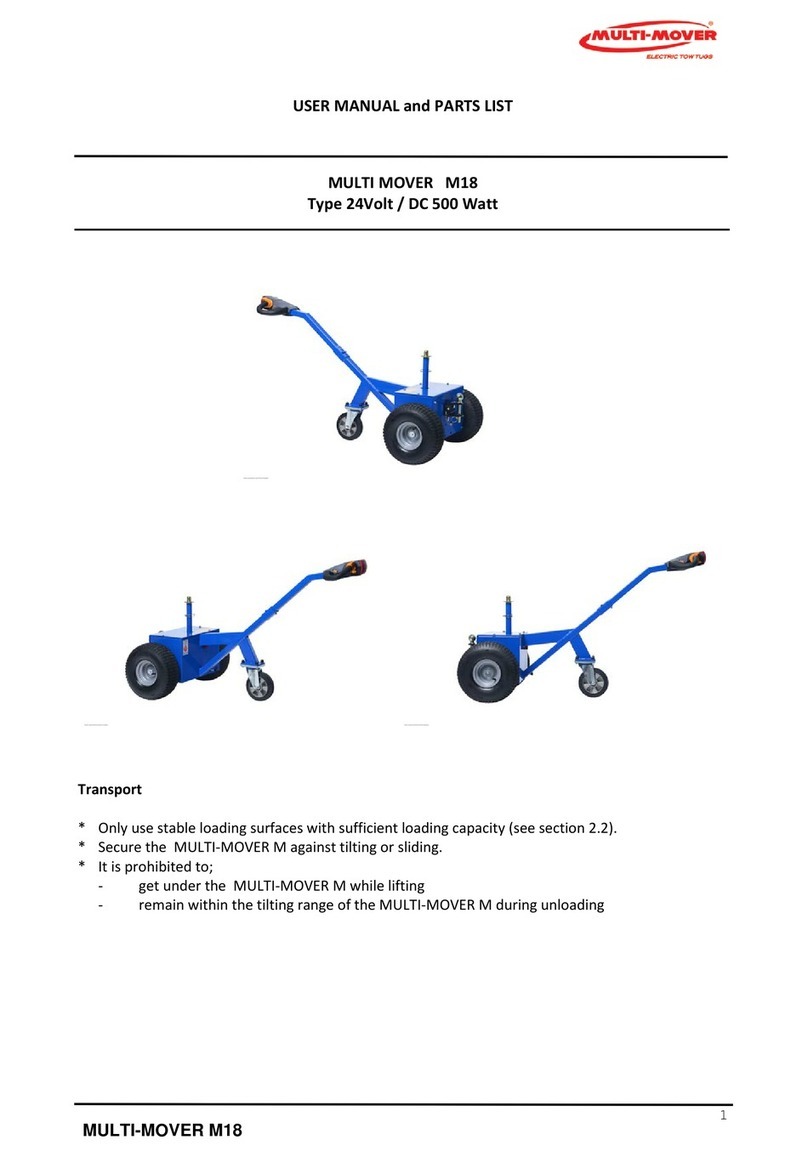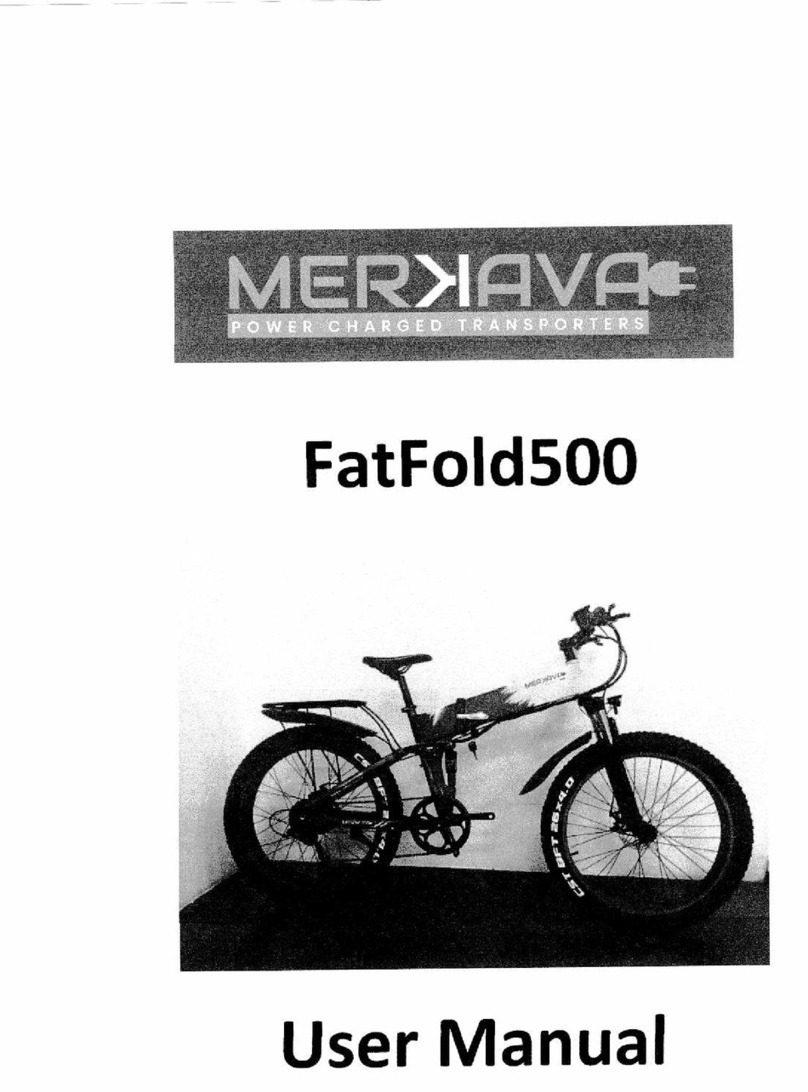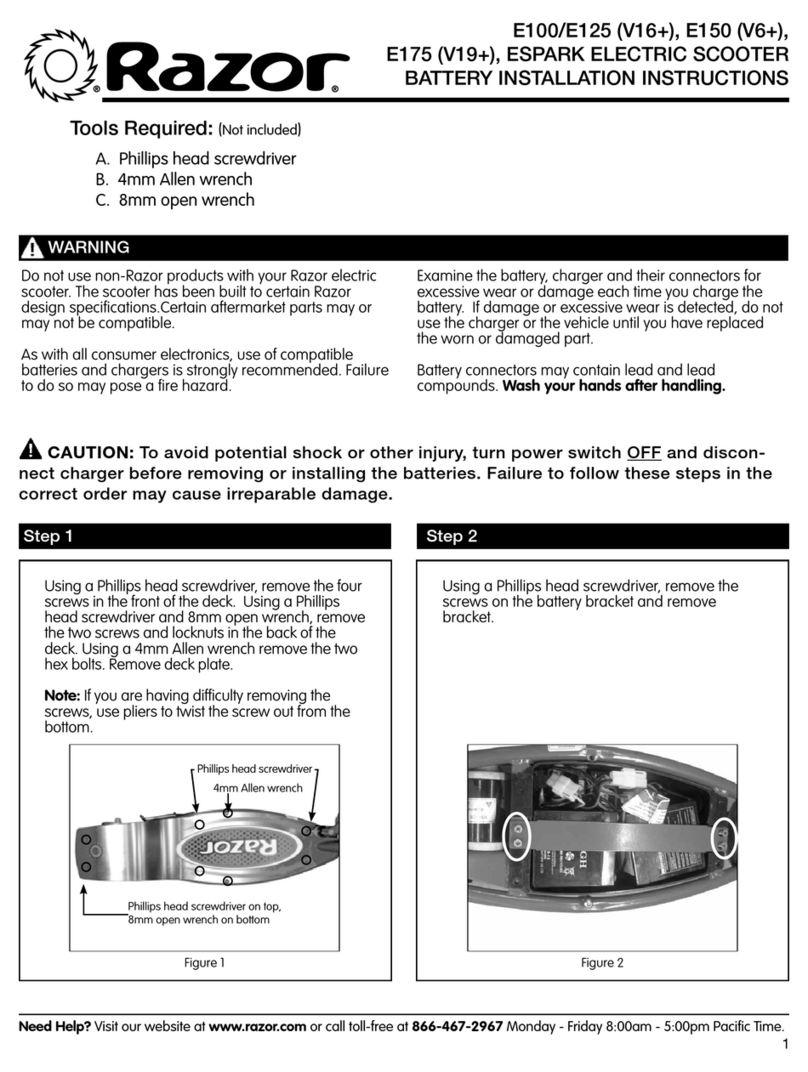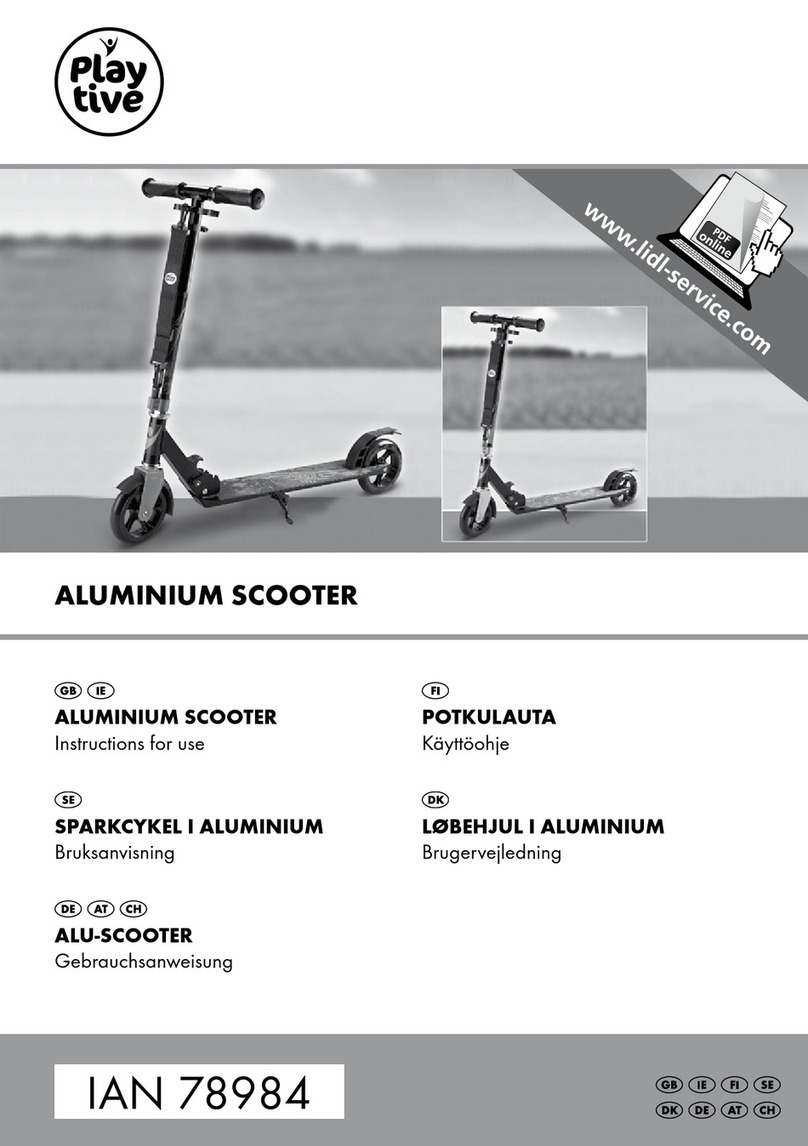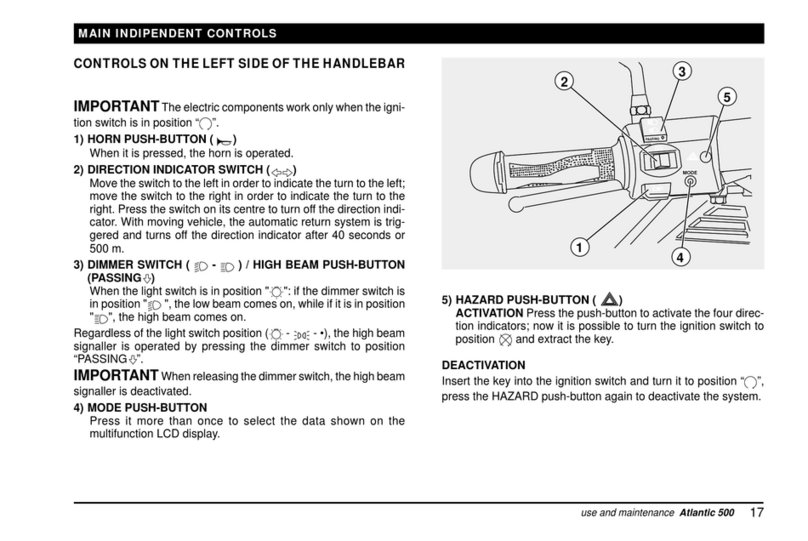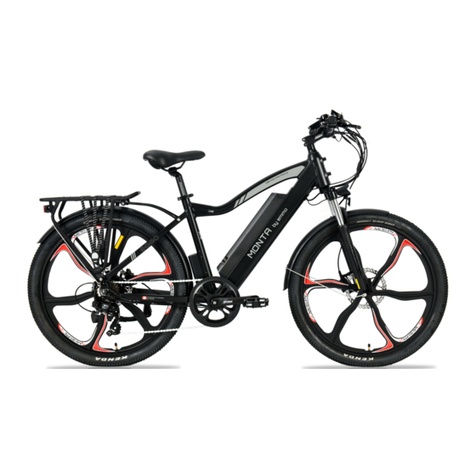EWheels Medical EW-M41 User manual

EW-M41 Instruction Booklet
MOBILITY SCOOTER
MOBILITY SCOOTER
MOBILITY SCOOTER

EW-M41 Instruction Booklet
TABLE OF CONTENTS
INTRODUCTION
IMPORTANT PRECAUTIONS
SAFETY INFORMATION ON ELECTROMAGNETIC
INTERFERENCE (EMI)
IDENTIFICATION OF PARTS
SAFETY WARNING & INSTRUCTION LABELS
OPERATING YOUR SCOOTER
CHARGING THE BATTERIES
DISASSEMBLING YOUR SCOOTER
TROUBLESHOOTING
CARE AND MAINTENANCE
CAUTION
SPECIFICATION
----------------------------------------------------------1
------------------------------------------2
--------------------------------------------------3
-------------------------------------------5
--------------------6
---------------------------------------7
----------------------------------------10
-------------------------------12
--------------------------------------------------13
------------------------------------------14
-----------------------------------------------------------------15
--------------------------------------------------------16

Instruction BookletEW-M41
INTRODUCTION
1
If you have any question, you can contact :
or your local dealer:
Ewheels Medical
6242E Greenway
Parkway #100
Scottsdale, Arizona
85254, U.S.A
CAUTION :
Federal law restricts this device to sale by or on the order of a physician or other
certified personnel licensed by the law of the state (US only) or region in which this
personnel practices to use or order the use of this device.
1
Thank you and congratulations on purchasing your new Ewheels Medical Mobility
Scooter. It is designed to provide you with transportation ability indoors and outdoors.
We pride ourselves on providing safe and comfortable products. Our goal is to ensure
your complete satisfaction. We sincerely hope you enjoy your Ewheels Medical Mobility
Scooter.
Please read and observe all warnings and instructions provided in the owner's manual
before you operate any function of this scooter. Also, please retain this manual for future
reference.

Instruction BookletEW-M41
IMPORTANT PRECAUTIONS
2
•Only one person at a time could ride a Ewheels Medical Mobility Scooter.
•Maximum load is 136 kg / 300 Ibs pounds.
•Turn the key off before getting on or off.
•Always drive carefully and be aware of others using the same area.
•If the mobility product is to be operated on public roads, the vehicle driver is responsible
for ensuring that it is in an operationally reliable condition. Inadequate or neglected care
and maintenance of the mobility product will result in a limitation of the manufacturer's
liability.
•If at all possible, avoid driving on slippery surfaces (such as snow, gravel, ice, etc.) Where
there is a danger of you losing control over the vehicle, especially on a gradient!
•Never attempt to ascend or descend a slope on slippery surfaces or where there is a
danger of skidding.
•Always use pedestrian crossings wherever possible. Take extreme care when crossing
roads.
•
Do not drive on slopes exceeding 8 degree, and take extreme care when turning on a slope.
•Do not use full power when turning a sharp corner.
•Take great care and drive at low speed when backing up, riding downhill or on uneven
surfaces, and climbing kerbs.
•Use the lowest speed when driving on descending road or uneven terrain.
If speed is too fast, leave your hand off the handle bar, let the scooter come to a stop.
Ensure it is safe to start again.
•The weight capacity limit will vary at ramp degree (please refer to following picture).
•A slow speed must always be used when ascending, descending or traversing aslope
or incline and also on uneven terrain, ramps and soft or loose surfaces, such as gravel
or grass.
•To prevent any danger, do not turn at high speed on ascending, descending ramp.
•Scooter may not operate well in high humidity.
•Avoid using the scooter during poor weather conditions, such as rain or snow.
•
Direct exposure to rain or humid conditions will cause the scooter to malfunction electrically
and mechanically; This will also cause the scooter to prematurely rust.
•Never leave the scooter in neutral when parked on slopes.
•Follow all relevant traffic laws when riding outside.
•When the scooter is being transported, do not sit or stay on scooter.
•Any unauthorized modification is prohibited. Please do not attempt to modify the scooter
yourself.
•Never use the scooter while under the influence of fireworks. Keep away from flammable
objects while charging as it may lead to fire or explosion of battery or oxygen tank.
•Do not smoke while charging as the battery may release hydrogen gas. Please charge
your battery in a well-ventilated space.
•The grade climbing degree will be affected by weight capacity, driving speed, ramp degree, and scooter parameter.
•To prevent any danger from motor defected; please avoid to drive on long ramp or any uneven terrain.
•To prevent damage to the motor, avoid driving on long 8 degree ramps or uneven terrain.
45kg /
8 degree 50kg /
6 degree 91kg /
4 degree 136kg /
3 degree

Instruction BookletEW-M41
3
SAFETY INFORMATION ON
ELECTROMAGNETIC INTERFERENCE (EMI)
CAUTION : It is very important that you read this information regarding the possible
effects of Electromagnetic Interference on your motorised scooter.
Powered wheelchairs and motorised scooters may be susceptible to electromagnetic
interference (EMI), which is interfering electromagnetic energy (EM) emitted from sources
such a radio stations, TV stations, amateur radio (HAM) transmitters, two-way radios,
and mobile phones. The interference (from radio wave sources) can cause the motorised
scooter to release its brakes, move by itself, or move in unintended directions. It can also
permanently damage the motorised scooter control system. The intensity of the interfering
EM energy can be measured in volts per meter (V/m). Each motorised scooter can resist
EMI up to certain intensity. This is called its "immunity level." The higher the immunity
level, the greater the protection. At this time, current technology is capable of achieving
at least a 20 V/m immunity level, which would provide useful protection from the more
common sources of radiated EMI. This immunity level of this motorised scooter model
is 20 V/m.
There are a number of sources of relatively intense electromagnetic fields in the everyday
environment. Some of these sources are obvious and easy to avoid. Others are not apparent
and exposure is unavoidable. However, we believe that by following the warnings listed
below, your risk to EMI will be minimised.
1.Hand-held portable transceivers (transmitters-receivers) with the antenna mounted
directly on the transmitting unit. Examples include: citizens band (CB) radios, "walkie
talkie," security, fire, and police transceivers, mobile telephones, and other personal
communication devices;
2.Medium-range mobile transceivers, such as those used in police cars, fire trucks,
ambulances, and taxis. These usually have the antenna mounted on the outside of the
vehicle; and
3.Long-range transmitters and transceivers such as commercial broadcast transmitters
(radio and TV broadcast antenna towers) and amateur (HAM) radios.
The sources of radiated EMI can be broadly classified into three types :
WARNING : Some mobile telephones and similar devices transmit signals while they are
ON, even when not being used.
WARNING : Other types of hand-held devices, such as cordless phones, laptop computers,
AM/FM radios, TV sets, CD players, and cassette players, and small appliances,
such as electric shavers and hair dryers, so far as we know, are not likely to
cause EMI problems to your motorised scooter.

Instruction BookletEW-M41
4
WARNING : There is no easy way to evaluate their effect on the overall immunity of the
motorised scooter.
Motorised Scooter Electromagnetic Interference :
Because EM energy rapidly becomes more intense as one moves closer to the transmitting
antenna (source), the EM fields from hand-held radio wave sources (transceivers) are of
special concern. It is possible to unintentionally bring high levels of EM energy very close
to the motorised scooter control system while using these devices. This can affect motorised
scooter movement and braking. Therefore, the warnings listed below are recommended to
prevent possible interference with the control system of the motorised scooter.
Warnings :
Electromagnetic interference (EMI) from sources such as radio and TV stations, amateur
radio (HAM) transmitters, two-way radios, and mobile phones can affect motorised scooters.
Following the warnings listed below should reduce the chance of unintended brake release
or motorised scooter movement which could result in serious injury.
1.Do not operate hand-held transceivers (transmitters-receivers), such as citizens band
(CB) radios, or turn ON personal communication devices, such as mobile phones, while
the motorised scooter is turned ON;
2.Be aware of nearby transmitters, such as radio or TV stations, being to them;
3.If unintended movement or brake release occurs, turn the motorised scooter OFF as
soon as it is safe;
4.Be aware that adding accessories components, or modifying the motorised scooter,
may make it more susceptible to EMI; and
Important Information :
1.20 volts per meter (V/m) is a generally achievable and useful immunity level against
EMI (as of May 1994). The higher the level, the greater the protection.
2.The immunity level of this product is 20 V/m.
5.Report all incidents of unintended movement or brake release to the distributor listed
on the inside front cover of this manual. Note whether there is a source of EMI nearby.

Instruction BookletEW-M41
Figure 2 - EW-M41 Top Control Panel
Figure 3 - EW-M41 Back View
Figure 1 - EW-M41 Front View
IDENTIFICATION OF PARTS
5
Before attempting to drive this scooter on your own, it is important that you familiarise
yourself with the controls, and how to operate them safely.
Horn Button
Throttle
Main Key Switch
Battery Gauge
Self-Diagnostic
Warning Light
Speed Dial
Knob
Reflectors
Anti-Tip Wheels
Free-
Wheeling
Lever
Rear Light (Optional Accessory)
Easy-To-Operate Control
Panel & Delta Handlebar Flip-Up Armrests
Front Basket
Padded
Foldable Seat
Solid Tires
Tiller Angle
Adjustment
Circuit Breaker
Seat Rotation
Lever
Release Lever
Reflector
Charging Socket
LED Headlight

Instruction BookletEW-M41
Figure 4 - EW-M41 Front View
Figure 5 - EW-M41 Back View
6
SAFETY WARNING & INSTRUCTION LABELS
Serial no.
1
EU representative label
2
Power warning label
3
Instruction of battery lock nut label
Warning label
Keep hands away
Instruction label
Dismantling the
front and rear
frame of scooter
Wiring diagram
for batteries
Freewheel instruction label
When lever is in N (Neutral)
position, scooter can be
moved without power.
When lever is in D (Drive)
position, scooter can be
driven.
4
5
6
7
8

Instruction BookletEW-M41
OPERATING YOUR SCOOTER
7
WARNING : Always ensure that the scooter is switched
OFF before getting on or off the scooter
and before removing any items from the
scooter.
WARNING : Turning the scooter OFF whilst driving
will bring the scooter to an abrupt stop
FUNCTION OF PARTS:
Main Key Switch (C)
1.Turn the key to the right
Turn the scooter on.
2.Turn the key to the left and LED
head light on.
3.Turn the key to the center position
Turn the scooter off.
WARNING : Before driving the scooter, set the speed to low speed by turning the knob
towards turtle icon.
WARNING : Drive in high speed when encounter an up slope, and drive in low speed when
encounter a down slope.
WARNING : Releasing the throttle engages the automatic brake, However the scooter will
taxi for a short buffering distance, please keep safe distance when stopping
to prevent any collisions.
Speed Dial Knob (D)
The rabbit icon indicates fast or high speed. The turtle icon indicates slow or low speed. By
turning this Knob (D) towards chosen the icon, you can control the overall speed of the scooter.
Figure 7
Horn Button (E)
Press The Horn Button (E) once to sound a warning tone when necessary.
Battery Gauge (F)
The LEDs represents an approximation of battery capacity. If the charge is full, all LEDs
are lit. When only red and orange LEDs are lit, the batteries are almost consumed and
should be charged. When only red LEDs are lit, charge the batteries immediately.
Self Diagnostic Warning Light (G)
Flashing lights indicate there is a problem within scooter. See page 11 for more information.
Throttle (H) (H1)
To move forward, pull the right side of Throttle (H). To move backward, pull the left side
of Throttle (H1). (The movement directions can be reversed by local dealers if required.)
Releasing the throttle to engage automatic brake. These are also your accelerators, the
further you pull it, the faster you go. (Subject to the position of the Rabbit/Turtle control).
Figure 6
Before operation, please remove the Lock Nut (A) and
press button of Circuit Breaker (B) to activate the system.
(C)
(C) (B)
(H)(H1)
(E)
(D)
(F)(G)
(A)

Instruction BookletEW-M41
8
Figure 9
(J)
(K)
Figure 8
(I)
Figure 11
(L)
Figure 10
(B)
1.Turn the Cap (I) (outward upward) to disengage the pin.
2.Simultaneously, adjust the tiller fore-and-aft to the most comfortable angle. Release Cap
(I) and ensure the pin is fully engaged to lock the tiller in position.
1.Lift the Lever (J) upward to disengage the pin.
2.Simultaneously, rotate the seat (K) to the most comfortable angle.
To lock the seat in position, Release the lever (J) and ensure the pin is fully engaged.
If scooter's circuit system malfunctions or is over loaded, the circuit breaker will trip and
automatically shut down the power to ensure driver's safety. After shut down, press button
of Circuit Breaker (B) to reactive the circuit system.
If required the scooter can be pushed when the Free-Wheeling Lever (L) is disengaged.
To engage the Free-Wheeling Lever (L), Pull up the free-wheeling lever. To disengage the
Free-Wheeling Lever (L), Push down the free-wheeling lever.
NOTE: Ensure scooter is switched OFF!
Tiller Angle Adjustment :
Seat Rotation Adjustment :
Circuit Breaker :
Free-Wheeling Lever :

Instruction BookletEW-M41
9
Basket assembling and disassembling :
1.Place the Front Basket (M) to the bracket on the tiller.
2.Remove the Front Basket (M) and place it aside.
3.Weight : 3kg
Armrest assembling and angle adjustment :
1.Adjust armrest to most comfortable length, then lock
the Knob (N).
2.Adjust Screw (O) height to preferable armrest's angle
Seat Height adjustment :
1.Remove the seat, then screw, nut and washer from seat post.
2.Adjust seat post to desired height, then attached tightly with screw, nut and washers.
3.Assemble the seat back to its original position.
4.Seat height adjustability 520mm / 545mm / 570mm.
Figure 13
(O)
(N)
Figure 12
(M)
Figure 14

Instruction BookletEW-M41
10
CHARGING THE BATTERIES
Optional Charging
Socket (P1)
Figure 15
(P)
(Q)
WARNING : The time needed to recharge will vary depending on the depletion of the
batteries. Charging for longer than necessary will not harm the batteries.
They can not be overcharged.
Battery shelf life :
‧Standby use battery life :
3 ~ 5 years under 2.3Vpc and
20oC floating charge condition.
‧Cycle use battery life :
200 cycles (100%DOD)
225 cycles ( 80%DOD)
500 cycles ( 50%DOD)
Your Ewheels Medical scooter is equipped with two sealed, maintanence free 12V. 22ah lead acid.
rechargeable batteries and one EW-M41 24V/5Acharger. Batteries must be charged before
using the scooter for first time and should be recharged after each day's use. Ensure
the power switch is in the OFF position and free-wheeling lever is not in freewheel mode.
For safety reasons, only sealed non-spillable batteries that meet DOT CFR 173.159(d),
IATA Packing Instructions, and IATA Provision A67 shall be installed in the scooters. If
new batteries are required, contact your dealer.
1.Insert battery charger cord into Charging Socket
(P) on battery pack.
2.Plug other end of Power Cable (Q) into a standard
electrical wall outlet.
3.LED Indication
LED (Power) - RED Light on : Power on
LED (Charge) - ORANGE Light on : Charging
GREEN Light on : Fully charged
4.Allow batteries to charge until charging indicator
turns green.
5.After indicator turns green, unplug battery charger from scooter and wall outlet.
6.Do not charge simultaneously with battery box socket and optional charging socket,as
this will cause serious risk free or electrocution.
7.If at any time the battery charger light flashes green over 40 minutes, this indicates
abnormal charging occurred.
You should check the following :
‧Charger plug is correctly positioned
‧Scooter is turned off
‧If none of these are the problems, contact your local authorised dealer.
Batteries will lose capacity due to self-discharge through
packing, transportation and storage process at various
temperatures. The relation between battery capacity and
storage temperature and time is as follows :
Storage
temperature
Not
allowed
1 month
96%
92%
90%
83%
0oC~ 5oC
5oC~ 20oC
20oC~ 30oC
20oC~ 40oC
3 month
93%
90%
80%
70%
6 month
90%
80%
65%
50%
12 month
80%
65%
50%

Instruction BookletEW-M41
11
Keep in mind these rules:
•Fully charge the batteries at least once a month, or more if you use scooter regularly.
Charge after each trip exceeding 3 kilometers.
•If storing your scooter for some time (1 month or more), make sure that batteries are
fully charged, and on returning, charge them again before using the scooter.
•
Batteries will only give maximum performance after scooter has been used, and batteries
have been recharged up to 10 times.
Please be aware that the travelling range of your mobility scooter is impacted by how fast the batteries
are discharged. This will depend on many circumstances, such as ambient temperature, condition of the
surface of the road, tyre pressure, weight of the driver, driving environment (inclines etc.) and utilisation
of your lighting system if fitted. We recommend that you test your local ride with a family member to
ensure a safe journey.

Instruction BookletEW-M41
WARNING : When assembling battery pack (S), make sure to aim for the battery terminal
connection for proper electricity conductivity.
WARNING : Re-assembling your scooter by vise versa above disassembling procedures.
12
DISASSEMBLING YOUR SCOOTER
I. Seat Disassembling :
Remove seat by lifting Seat Rotation Lever (J). Then rotate Seat (K) and lift up away from scooter.
II. Battery Pack Disassembling :
As indication, pull Battery Pack Handle (R) to remove Battery Box (S) from scooter.
Caution : Battery Box is heavy. When lifting, please use correct lifting posture to avoid injury.
Ask for assistance if necessary.
Figure 17
(R)
(S)
Figure 16
(J)
(K)
III. Front & Rear Frame Disassembling :
Hold front & rear frame with Release Lever (T) to disassemble front and rear frame.
Figure 19
Figure 18
(T)
Figure 21
Figure 20
(I)
(U)
Turn the Cap (I) to fold down the Tiller (U) to the lowest position as shown in Figure 20.
When the Tiller (U) is in the lowest position it can be locked by the pin of tiller angle
adjustment.
Tiller Fold Method :
The Scooter can be disassembled into 7 main parts as shown in Figure 21.
Completion of Disassembling:

Instruction BookletEW-M41
13
TROUBLESHOOTING
Flash Description Meaning
1Battery Low The batteries are running low.
•Recharge the batteries
2Low Battery Fault The batteries have run out of charge.
•Recharge the batteries.
3High Battery Fault Battery voltage is too high. This may occur if
overcharged &/or traveling down a long slope.
•If traveling down a slope, reduce your
speed to minimise the amount of
regenerative charging.
•Check the battery and associated
connections and wiring.
4Current Limit Time-out The motor has been exceeding its maximum
current rating for too long. This may be due
to a faulty motor.
•Check the motor and associated
connections and wiring.
•Turn the controller off, leave for a few
minutes and turn back on again.
5Park Brake Fault Either a park brake release switch is active
or the park brake is faulty.
•Check the park brake and associated
connections and wiring.
•Ensure any associated switches are in their
correct positions.
6Throttle OONAPU The Throttle is out of neutral when turning the
controller on.
•Ensure the throttle is in neutral when turning
the controller on.
•The Throttle may require re-calibration.
7Speed Pot Fault The throttle, speed limit pot or their associated
wiring may be faulty.
•Check the throttle and speed pot and
associated connections and wiring.
8Motor Voltage Fault The motor or its associated wiring is faulty.
•Check the motor and associated
connections and wiring.
9Other error The controller may have an internal fault.
•Check all connections & wiring.

Instruction BookletEW-M41
14
CARE AND MAINTENANCE
1.Before using the mobility scooter, make sure all nuts and bolts are tight. Check all parts
for damage or wear and replace where required. Check all parts for correct placements
and adequate adjustments.
2.Ensure that batteries are well maintained and charged as instructed in page 9 in this
manual.
3.The wheels and tires should be checked periodically for cracks and wear, and should
be replaced by a qualified technician.
4.Regularly check for loose nuts and/or bolts in the front and drive wheels. If loose, have
them adjusted by a qualified technician.
5.Clean, dust and grease from exposed components.
6.Periodically have the bearings of the front wheel checked to make sure they are clean
and free from rust or moisture hazards.
Recommended maintenance procedures :
Before cleaning the mobility scooter, use the following tips:
‧Only use a damp cloth and gentle detergent.
‧Do not apply any abrasive or acidic substances during cleaning of the scooter, to avoid
damages to the scooter.
‧Do not use high-pressure hose to clean your scooter.
‧Do not allow any direct contact with water on any of the electrical parts of this scooter.
Cleaning your mobility scooter :

Instruction BookletEW-M41
1.Obstacle Climbing :
Your scooter can climb obstacles and kerbs of up to 40mm / 1.6" in height. Never attempt
to overcome an obstacle when on an uphill or downhill gradient!
Always approach obstacles straight on! Ensure that the front wheels and rear wheels
move over the obstacle in one stroke, do not stop halfway!
2.The maximum gap the scooter can drive over is 100mm / 4",
1.Charge the batteries after each trip. If the scooter is not used for some time, batteries
may lose their charge. Batteries should be charged at least once a month. Store in a
dry loaction and disconnect batteries
2.Check the battery gauge before driving to prevent power depletion.
3.Batteries will have an aging phenomenon, where the storage capacity will gradually
decrease. If batteries are damaged, contact your local dealer for proper disposal.
4.Do not disassemble battery and open sealed parts by yourself to prevent electric shock
and burns from acid leakage,
5.Adjust speed to a slow speed when starting off to prevent sudden acceleration.
6.Never attempt to drive downhill backwards.
7.Avoid driving the scooter at night, in rain or bad weather.
Others :
•When driving scooter on ramp, adjust your bodies center of gravity to keep the scooter
more safe and secure.
General driving posture On ramp, forward your body to allow
scooter to move more safety
15
CAUTION

Instruction BookletEW-M41
16
SPECIFICATION
Overall Length
Overall Width
Overall Height
Front Wheels
Rear Wheels
Weight W/ Batteries
Weight Of Heaviest Piece
Max. Speed
Weight Capacity
Ground Clearance
Grade Climbable
Curb Climbable
Turning Radius
Suspension
Brake
Seat Type
Seat Width
Motor Size
Battery Size
Battery Weight
Travel Range
Battery Charger
Electronics
*Subject to change without notice. ( Rev. 1, 2018/12/07 )
44"
23"
37"
9"
9"
121 lbs
38 lbs
5 mph
300 lbs
2"
8 degree
2"
57"
Rear (Option)
Electro-Mechanical
Swivel Light Weight Foldable
18"
250W, 4000 r.p.m
(2) 12V. 22Ah
34 lbs
11 Miles
3A Off Board
On / Off Key Switch,
Battery Level Indicator,
Speed Control Knob
Table of contents
Other EWheels Medical Scooter manuals
Popular Scooter manuals by other brands

MaxFoot
MaxFoot MF-19 manual
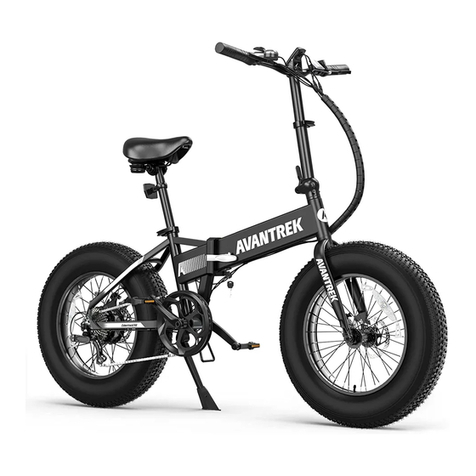
AVANTREK
AVANTREK Cybertrack 200 user manual

Authentic Sports & Toys
Authentic Sports & Toys SIX DEGREES RS owner's manual
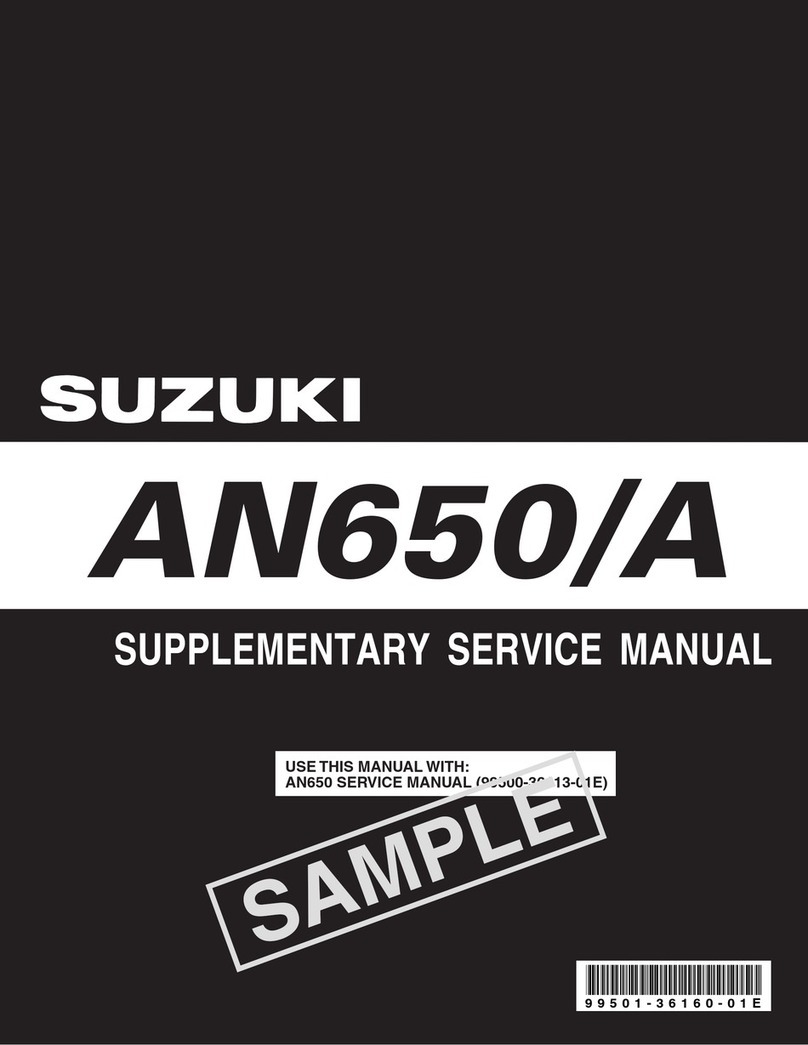
Suzuki
Suzuki AN650/A Supplementary service manual

Shoprider
Shoprider LITTLE BEAUTY With SUSPENSION owner's manual
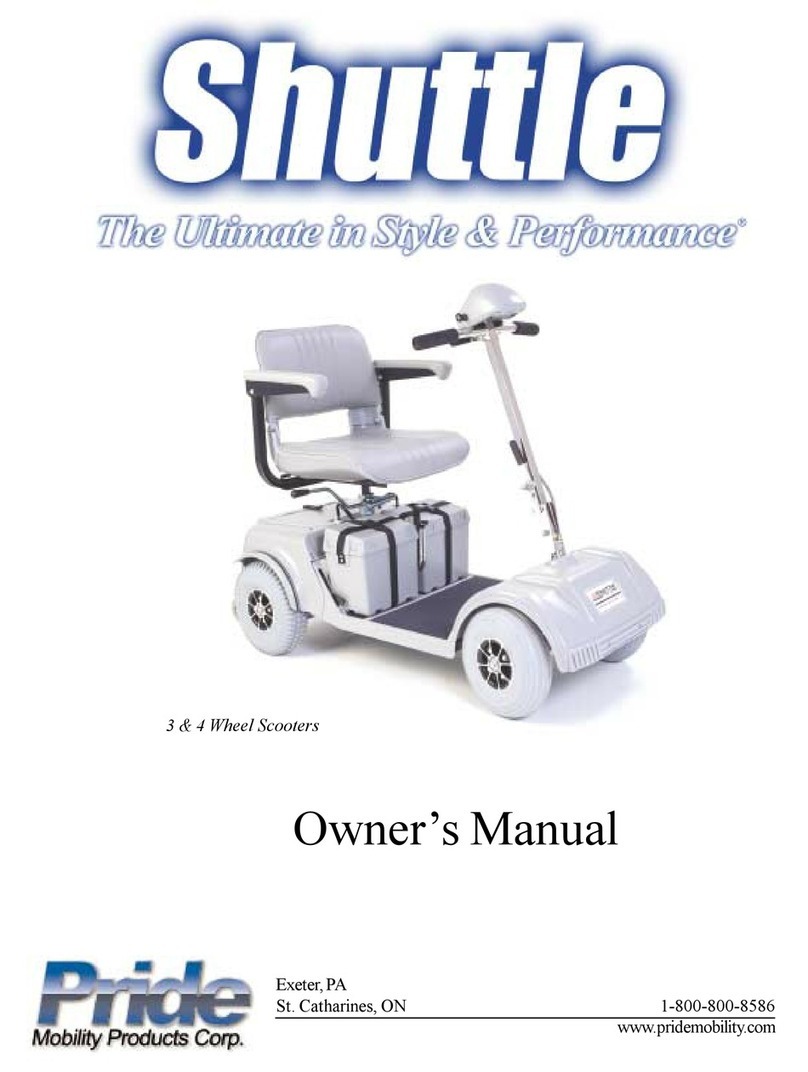
Pride Mobility
Pride Mobility Shuttle owner's manual




